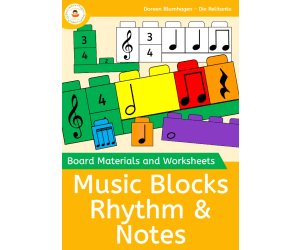Music Presentation
Make music education interactive with presentations that combine visuals and audio. These resources cover topics such as rhythm, melody, and instrument families. Incorporate them to create an immersive learning experience that captivates your students.
Music Building Blocks: Learn Rhythm and Note Values
Creative Arts, Music, Early Learning, Elementary, Presentations, Teacher Tools, Worksheets & Printables, Flashcards, Worksheets
Music Building Blocks: Learn Rhythm and Note Values Through Hands-On Activities Engage your students with this innovative music education resource designed to teach time signatures , note values , and rhythm practice in a creative, hands-on way. Perfect for elementary music teachers , special education , and even non-specialist teachers , this material simplifies music theory concepts while keeping students actively involved. What’s Included? Note and Rest Blocks : Visual tools for understanding note durations (whole notes, half notes, quarter notes, and more). Time Signature Base Plates : Pre-marked plates for 2/4, 3/4, and 4/4 time signatures. Key Signature Cards : Treble and bass clefs to complete measures. Worksheets : Printable activities to reinforce concepts. Learning Objectives Understand time signatures and how measures are structured. Recognize note values and their durations. Develop a strong sense of rhythm through clapping, tapping, and playing. Why This Material? Versatile : Ideal for classroom teaching, homeschool settings, and group music lessons. Accessible : Easy-to-use for both experienced and non-specialist teachers. Interactive : Encourages tactile and auditory learning through music blocks, Boomwhackers, and Orff instruments. How to Use Cut out the blocks and create rhythms on the baseplates. Clap, tap, or use classroom instruments to perform the rhythms. Print and laminate the board materials for reuse. This resource transforms music theory into a fun, practical experience, making it perfect for beginners and younger learners. Start building a solid musical foundation today!
Author Die Relitante
Tags Music Education, Rhythm Practice, Time Signatures, Note Values, Hands-On Learning, Classroom Materials, Music Worksheets, Orff Instruments, Boomwhackers Activities, Elementary Music Teaching
Ada's Violin - Google Slides FREEBIE for Elementary Music!
Creative Arts, Art, Music, Grade 1, 2, 3, 4, 5, Presentations, Teacher Tools
Ada's Violin - Google Slides FREEBIE for Elementary Music Ada's Violin - Google Slides FREEBIE for Elementary Music complements the favorite storybook often used in elementary music classes. The magic of the citizens' inventive spirit in Cateura, Paraguay is a narrative that fascinates students, particularly when they discover it's based on true events. Resource Features: This interactive resource serves as an excellent guide to generate engaging discussions within the class. Before delving into the tale, it introduces pupils to Cateura and explains what a landfill is. This resource encourages students to contemplate recycling and devising alternative uses for junk material. Makes an apt lesson plan around Earth Day. Following the storytelling session (note: book not included), this recourse includes features designed to encourage learners to articulate their favourite elements from Ada’s story while contemplatively reflecting on problems and solutions mentioned therein. Thought-provoking prompts help them relate Ada and her community's struggles with their personal experiences. The Highlight: The highlight lies in its element of surprise where students learn about its real-life basis sparking interest among them! Concluding slides comprise information about 'Landfill Harmonic', along with an insightful short video (with subtitles). Suitable For: Ideal for Grades 1-5 Art & Music educators or any educator integrating literature into their curriculum offerings – public school teachers, homeschoolers included! Fosters environmental awareness alongside fostering empathy & resilience building amongst children – powerful lessons transcending beyond textbooks! Please note: File types include multiple formats giving users adaptability according to their teaching preference and technology availability. This product cultivates excitement, curiosity, compassion and creativity among young learners – making teaching & learning a much-enjoyed endeavour!
Author Magic of Music Ed
Tags Violins, Recycling, Storytelling, Landfill Harmonic, Environmental Awareness
Elements of Music | Music Activity and Presentation
Creative Arts, Art, Music, Grade 7, 8, 9, 10, 11, 12, Presentations, Teacher Tools
This Elements of Music project is perfect for new and old music students. Students will develop a presentation over the Elements of Music. Each project will be based around a popular song (one that has radio play/therefore the song should be appropriate to play in class) and the song will be incorporated in the project. If the project is completed on PowerPoint (or something similar), the student should embed the video for the song into their presentation. If the student makes their project on a poster board, then they will have to play the song via the teacher’s computer. Students will build the background information from their draft copy into their project. Each Project should have all six of the Elements of Music in it; with each element being described using appropriate descriptive words.
Author DrDrew
Tags Music Activity, Presentation, Music Project, Elements Of Music, Descriptive Words




